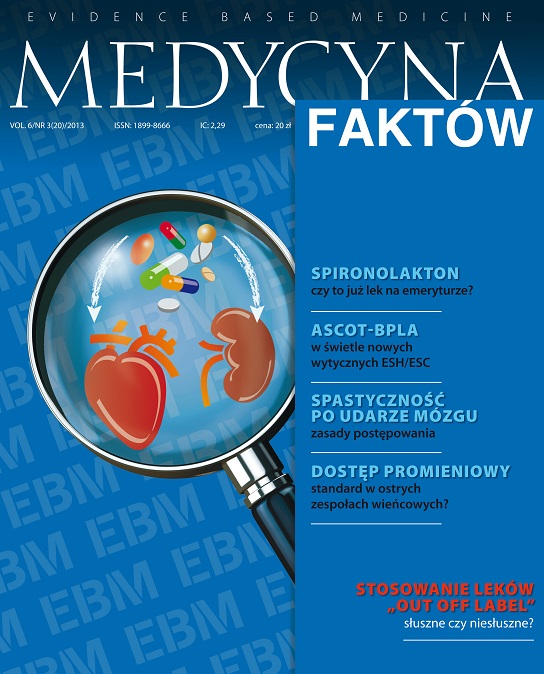Atorwastatyna w wysokich dawkach ? wskazania i bezpieczeństwo Artykuł przeglądowy
##plugins.themes.bootstrap3.article.main##
Abstrakt
Stosowanie statyn zaleca się w ramach profilaktyki pierwotnej i wtórnej chorób układu krążenia. Dostępne dane naukowe sugerują, że korzyści kliniczne z leczenia statynami zależą przede wszystkim od stopnia zmniejszenia stężenia cholesterolu LDL. Atorwastatyna jest jedną ze statyn najskuteczniej je obniżających. Stopień redukcji zależy od dawki i mieści się w przedziale od 39% do nawet 55% w przypadku zastosowania w dawce 80 mg/24 h. Jednak intensywne leczenie atorwastatyną jest stosowane rzadko z powodu obaw o bezpieczeństwo. Dostępne badania naukowe wskazują jednak, że intensywna terapia dużymi dawkami atorwastatyny jest bardzo skuteczna i bezpieczna w leczeniu krótko- i długoterminowym.
##plugins.themes.bootstrap3.article.details##
Copyright ? by Medical Education. All rights reserved.
Bibliografia
2. DRUGS.com. Lipitor.
3. Weng T.C., Yang Y.H., Lin S.J. et al.: A systematic review and meta-analysis on the therapeutic equivalence of statins. J. Clin. Pharm. Ther. 2010; 35: 139-151.
4. Zdrojewski T.: Epidemiologia zaburzeń lipidowych w Polsce. W: Aktualny stan wiedzy na temat statyn. Banach M., Filipiak J.K., Opolski G. (red.). Wydawnictwa Medyczne Termedia, Poznań 2013:17-21.
5. Ray K.K., Cannon C.P., McCabe C.H. et al.: Early and late benefits of high-dose atorvastatin in patients with acute coronary syndromes: results from the PROVE IT-TIMI 22 trial. J. Am. Coll. Cardiol. 2005; 46: 1405-1410.
6. Schwartz G.G., Olsson A.G., Ezekowitz M.D. et al.: Effects of atorvastatin on early recurrent ischemic events in acute coronary syndromes: the MIRACL study: a randomized controlled trial. JAMA 2001; 285: 1711-1718.
7. LaRosa J.C., Grundy S.M., Waters D.D. et al.: Intensive lipid lowering with atorvastatin in patients with stable coronary disease. N. Engl. J. Med. 2005; 352: 1425-1435.
8. Waters D.D., Guyton J.R., Herrington D.M. et al.: Treating to New Targets (TNT) Study: does lowering low-density lipoprotein cholesterol levels below currently recommended guidelines yield incremental clinical benefit? Am. J. Cardiol. 2004; 93: 154-8.
9. Amarenco P., Bogousslavsky J., Callahan A. 3rd et al.: Stroke Prevention by Aggressive Reduction in Cholesterol Levels (SPARCL). High-dose atorvastatin after stroke or transient ischemic attack. N. Engl. J. Med. 2006; 355: 549-559.
10. Nicholls S.J., Ballantyne C.M., Barter P.J. et al.: Effect of the intensive statin regiments on progression of coronary disease. N. Engl. J. Med. 2011; 365: 2078-2087.
11. Newman C., Tsai J., Szarek M. et al.: Comparative safety of atorvastatin 80 mg versus 10 mg derived from analysis of 49 completed trials in 14,236 patients. Am. J. Cardiol. 2006; 97: 61-67.
